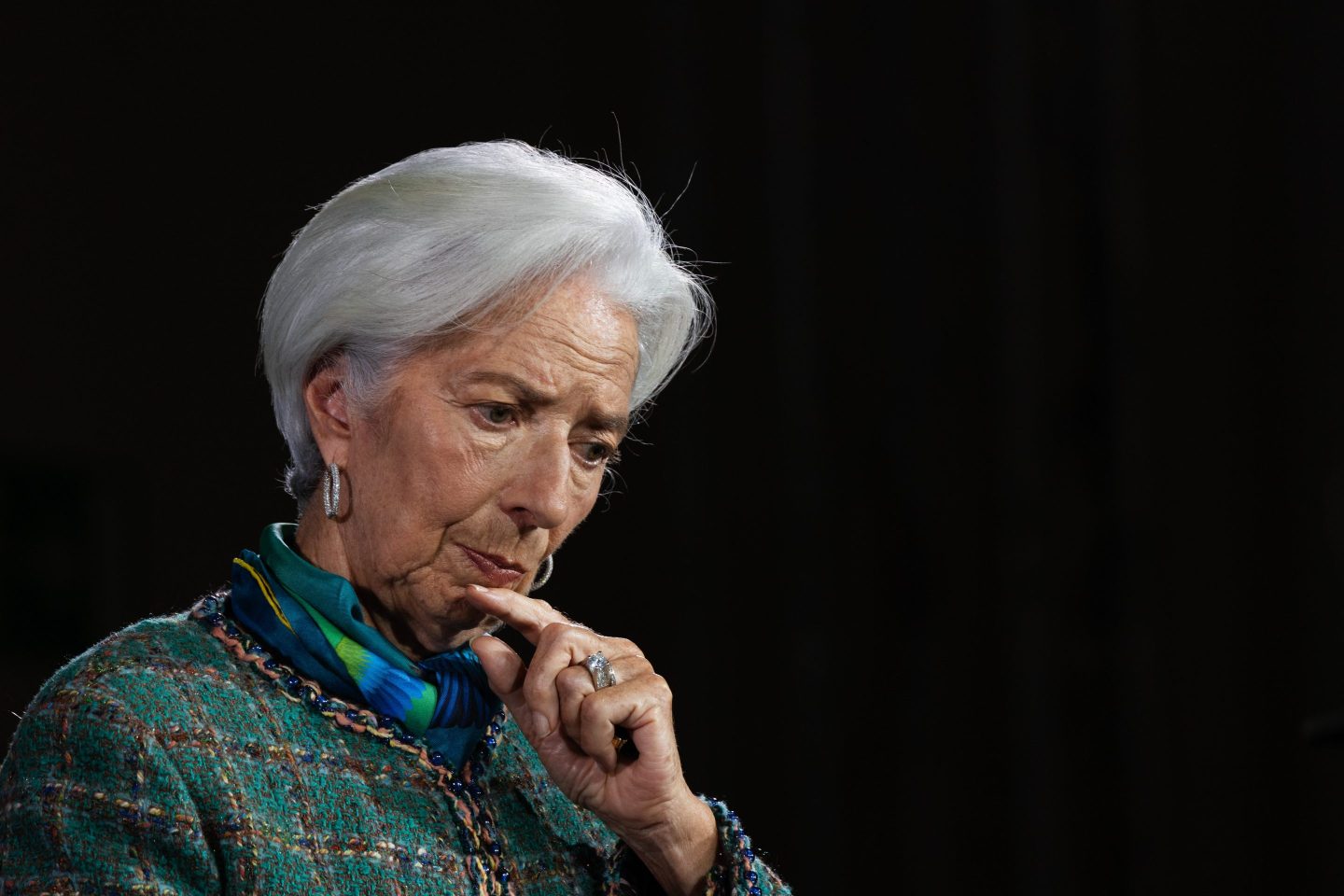
由于能源价格上涨、信贷成本上升以及前经济强国德国经济下滑,欧洲经济在2023年底未能实现扩张,停滞不前的状况延续了一年多。
欧盟统计机构欧盟统计局(Eurostat)周二公布的数据显示,去年10月至12月欧元区经济出现零增长,而在此之前的三个月,欧元区经济萎缩0.1%。
这延续了经济萎靡不振的悲惨局面:自2022年第三季度经济增长0.5%以来,20个欧盟成员国的经济就未曾出现过显著增长。
今年年初的情况也没有好转,商业活动指标仍然亮着收缩的红灯。此外,红海航运的中断限制了通过连接亚洲和欧洲的主要通道苏伊士运河的全球贸易,导致航运成本飙升,并有可能加剧通货膨胀。
新数据凸显了欧洲与美国之间日益扩大的鸿沟,美国经济第四季度较上一季度增长了0.8%,年增长率为3.3%,好于预期。
欧元区全年经济增长0.5%,而美国则增长了2.5%。
凯投宏观(Capital Economics)欧元区副首席经济学家杰克·艾伦-雷诺兹(Jack Allen-Reynolds)在一份书面分析报告中表示:“从大局来看,自2022年第三季度天然气价格飙升、欧洲央行开始加息以来,欧元区的国内生产总值一直持平。”
并非所有的消息都是坏消息。首先,失业率处于历史低点,第三季度的就业岗位有所增加。
尽管仍高于俄乌冲突爆发前的水平,但能源价格已从近期的飙升中回落,用于家庭供暖、工厂供电和发电的天然气储备容量也很充足。随着天然气储备容量达到72%,冬季供暖季也已接近尾声,人们对水电费上涨和另一场能源危机的担忧有所缓解。
在经济停滞不前的同时,通货膨胀率也从令人痛苦的两位数峰值迅速下降,去年12月降至2.9%。但人们的工资和购买力仍在逐渐恢复到物价飙升前的水平。
本周,法国农民在巴黎周围设置了路障,要求提高工资,减少限制,降低成本。
与此同时,欧洲央行(European Central Bank)采取的抗击通胀措施,如大幅加息,抑制了商业投资以及建筑和房屋销售等房地产活动。
欧洲最大的经济体德国去年第四季度萎缩0.3%。德国曾是经济增长的典范,但去年却成为主要发达经济体中表现最糟糕的国家之一。
德国受困于多重问题,包括俄罗斯切断了对欧洲大陆的大部分天然气供应,导致能源密集型产业的燃料价格上涨。德国还因缺乏熟练工人以及多年来为平衡预算而对基础设施和数字技术投资不足而受到拖累。
牛津经济研究院(Oxford Economics)的经济学家表示,尽管欧洲即将公布的数据“并未显示出显著改善”,而且可能预示着今年第一季度经济将略有萎缩,但欧元区将会从通胀率下降中受益,原因是通胀率下降正在恢复消费者购买力,而且预期会出现利率下调。
一些分析师预计,欧洲央行最早将在4月份降息,而另一些分析师则认为,欧洲央行可能要等到6月份才会降息,以确保通胀完全得到控制。
但风险依然存在,包括也门叛军胡塞武装在以色列-哈马斯战争期间,在红海对船只发起袭击。红海的贸易量占全球贸易的12%。
由于航运公司安排船只绕道非洲南端,导致运输成本上涨,使航程增加一周或更长时间。随着运输成本增加,以及从服装到键盘组件等产品出现延误,人们越来越担心,如果加沙冲突持续或升级,消费者价格可能会出现新一轮上涨。
牛津经济研究院表示,贸易中断可能会使核心通胀率上升多达0.5%,该指标不包括波动较大的燃料和食品价格。核心通胀受到欧洲央行的密切关注。
牛津经济研究院的分析师在一份报告中称:“我们认为,贸易中断对核心通胀率的影响将足以让欧洲央行再等一段时间”,将降息推迟到6月份。(财富中文网)
译者:中慧言-王芳
由于能源价格上涨、信贷成本上升以及前经济强国德国经济下滑,欧洲经济在2023年底未能实现扩张,停滞不前的状况延续了一年多。
欧盟统计机构欧盟统计局(Eurostat)周二公布的数据显示,去年10月至12月欧元区经济出现零增长,而在此之前的三个月,欧元区经济萎缩0.1%。
这延续了经济萎靡不振的悲惨局面:自2022年第三季度经济增长0.5%以来,20个欧盟成员国的经济就未曾出现过显著增长。
今年年初的情况也没有好转,商业活动指标仍然亮着收缩的红灯。此外,红海航运的中断限制了通过连接亚洲和欧洲的主要通道苏伊士运河的全球贸易,导致航运成本飙升,并有可能加剧通货膨胀。
新数据凸显了欧洲与美国之间日益扩大的鸿沟,美国经济第四季度较上一季度增长了0.8%,年增长率为3.3%,好于预期。
欧元区全年经济增长0.5%,而美国则增长了2.5%。
凯投宏观(Capital Economics)欧元区副首席经济学家杰克·艾伦-雷诺兹(Jack Allen-Reynolds)在一份书面分析报告中表示:“从大局来看,自2022年第三季度天然气价格飙升、欧洲央行开始加息以来,欧元区的国内生产总值一直持平。”
并非所有的消息都是坏消息。首先,失业率处于历史低点,第三季度的就业岗位有所增加。
尽管仍高于俄乌冲突爆发前的水平,但能源价格已从近期的飙升中回落,用于家庭供暖、工厂供电和发电的天然气储备容量也很充足。随着天然气储备容量达到72%,冬季供暖季也已接近尾声,人们对水电费上涨和另一场能源危机的担忧有所缓解。
在经济停滞不前的同时,通货膨胀率也从令人痛苦的两位数峰值迅速下降,去年12月降至2.9%。但人们的工资和购买力仍在逐渐恢复到物价飙升前的水平。
本周,法国农民在巴黎周围设置了路障,要求提高工资,减少限制,降低成本。
与此同时,欧洲央行(European Central Bank)采取的抗击通胀措施,如大幅加息,抑制了商业投资以及建筑和房屋销售等房地产活动。
欧洲最大的经济体德国去年第四季度萎缩0.3%。德国曾是经济增长的典范,但去年却成为主要发达经济体中表现最糟糕的国家之一。
德国受困于多重问题,包括俄罗斯切断了对欧洲大陆的大部分天然气供应,导致能源密集型产业的燃料价格上涨。德国还因缺乏熟练工人以及多年来为平衡预算而对基础设施和数字技术投资不足而受到拖累。
牛津经济研究院(Oxford Economics)的经济学家表示,尽管欧洲即将公布的数据“并未显示出显著改善”,而且可能预示着今年第一季度经济将略有萎缩,但欧元区将会从通胀率下降中受益,原因是通胀率下降正在恢复消费者购买力,而且预期会出现利率下调。
一些分析师预计,欧洲央行最早将在4月份降息,而另一些分析师则认为,欧洲央行可能要等到6月份才会降息,以确保通胀完全得到控制。
但风险依然存在,包括也门叛军胡塞武装在以色列-哈马斯战争期间,在红海对船只发起袭击。红海的贸易量占全球贸易的12%。
由于航运公司安排船只绕道非洲南端,导致运输成本上涨,使航程增加一周或更长时间。随着运输成本增加,以及从服装到键盘组件等产品出现延误,人们越来越担心,如果加沙冲突持续或升级,消费者价格可能会出现新一轮上涨。
牛津经济研究院表示,贸易中断可能会使核心通胀率上升多达0.5%,该指标不包括波动较大的燃料和食品价格。核心通胀受到欧洲央行的密切关注。
牛津经济研究院的分析师在一份报告中称:"我们认为,贸易中断对核心通胀率的影响将足以让欧洲央行再等一段时间",将降息推迟到6月份。(财富中文网)
译者:中慧言-王芳
Europe’s economy failed to expand at the end of 2023, dragging out the stagnation for more than a year amid higher energy prices, costlier credit and a downturn in former powerhouse Germany.
Zero economic growth for the October-to-December period of last year follows a 0.1% contraction in the three months before that, according to figures released Tuesday by EU statistics agency Eurostat.
That extends a miserable run of economic blahs: The 20 countries that use the euro currency have not shown significant growth since the third quarter of 2022, when the economy grew 0.5%.
And the start of this year looks no better, with indicators of business activity still flashing red for contraction. Plus, disruptions to shipping in the Red Sea have constricted global trade through the Suez Canal, a major route between Asia and Europe, surging shipping costs and threatening to boost inflation.
The new figures underlined the growing divide between Europe and the United States, whose economy grew 0.8% in the fourth quarter compared with the previous three-month period, or an annual pace of 3.3% — better than expected.
The eurozone grew 0.5% for the full year, while the U.S. grew 2.5%.
“The big picture is that eurozone GDP has been flat since the third quarter of 2022 when gas prices surged and the ECB started raising interest rates,” Jack Allen-Reynolds, deputy chief eurozone economist at Capital Economics, said in a written analysis.
Not all the news is bad. For one thing, unemployment is at record lows and the number of jobs rose in the July-to-September quarter.
Energy prices also have come down from recent spikes — though they remain higher than before Russia invaded Ukraine — and storage levels of natural gas, which is used to heat homes, power factories and generate electricity, are robust. With gas storage 72% full and most of the winter heating season nearly over, fears of higher utility bills and another energy crisis have eased.
While the economy has stagnated, inflation also has declined rapidly from its painful double-digit peak, falling to 2.9% in December. But people’s pay and purchasing power are still catching up to the levels lost through the price surge.
It’s seen as French farmers pushing for better pay, fewer constraints and lower costs have set up barricades around Paris this week.
Meanwhile, the anti-inflation medicine applied by the European Central Bank — sharply higher interest rates — has curbed business investment and real estate activity like construction and home sales.
Europe’s biggest economy, Germany, shrank 0.3% in the fourth quarter. Formerly a model in how to grow, Germany was one of the worst-performing major developed economies last year.
It is bogged down with multiple issues including higher fuel prices for energy-intensive industries after Russia cut off most of its natural gas to the continent. Germany also has been held back by lack of skilled workers and years of underinvestment in infrastructure and digital technology in favor of balanced budgets.
While the incoming numbers for Europe “don’t point to a significant improvement” and could signal a slight contraction in the first three months of this year, the eurozone should benefit from falling inflation that is restoring consumer purchasing power and expected lower interest rates, according to economists at Oxford Economics.
Some analysts expect the ECB to cut interest rates as early as April, while others think the central bank may wait until June to ensure inflation is definitely under control.
But risks remain, including the attacks by Yemen’s Houthi rebels on ships in the Red Sea, where 12% of global trade passes, amid Israel’s war on Hamas.
Transport costs have risen as shipping companies route vessels around the southern tip of Africa, adding a week or more to voyages. With higher shipping costs and delays to products from clothes to keyboard components, concerns are growing of new consumer price spikes if the conflict in Gaza drags on or escalates.
The trade disruption could add as much as 0.5% to core inflation, which excludes volatile fuel and food prices, Oxford Economics said. Core inflation is closely watched by the ECB.
“We think the impact on core inflation will be enough for the ECB to wait a little bit longer,” delaying lower rates to June, Oxford Economics analysts said in a note.






